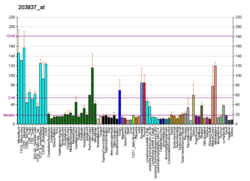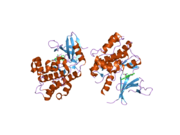Apoptosis signal-regulating kinase 1 (ASK1) also known as mitogen-activated protein kinase 5 (MAP3K5) is a member of MAP kinase family and as such a part of mitogen-activated protein kinase pathway. It activates c-Jun N-terminal kinase (JNK) and p38 mitogen-activated protein kinases in a Raf-independent fashion in response to an array of stresses such as oxidative stress, endoplasmic reticulum stress and calcium influx. ASK1 has been found to be involved in cancer, diabetes, rheumatoid arthritis, cardiovascular and neurodegenerative diseases.[5][6]
MAP3K5 gene coding for the protein is located on chromosome 6 at locus 6q22.33.[7] and the transcribed protein contains 1,374 amino acids with 11 kinase subdomains.[citation needed] Northern blot analysis shows that MAP3K5 transcript is abundant in human heart and pancreas.[8]
Mechanism of activation
[edit]Under nonstress conditions ASK1 is oligomerized (a requirement for its activation) through its C-terminal coiled-coil domain (CCC), but remains in an inactive form by the suppressive effect of reduced thioredoxin (Trx) and calcium and integrin binding protein 1 (CIB1).[9] Trx inhibits ASK1 kinase activity by direct binding to its N-terminal coiled-coil domain (NCC). Trx and CIB1 regulate ASK1 activation in a redox- or calcium- sensitive manner, respectively. Both appear to compete with TNF-α receptor-associated factor 2 (TRAF2), an ASK1 activator. TRAF2 and TRAF6 are then recruited to ASK1 to form a larger molecular mass complex.[10] Subsequently, ASK1 forms homo-oligomeric interactions not only through the CCC, but also the NCC, which leads to full activation of ASK1 through autophosphorylation at threonine 845.[11]
ASK1 gene transcription can be induced by inflammatory cytokines such as IL-1 and TNF-α through the activation of the NF-kb protein RelA.[6] Interestingly, TNF-α is also able to stabilize the ASK1 protein through deubiquitination.[12] Thus, unlike other members of the mitogen-activated protein kinase family, the regulation of ASK1 expression is transcriptional as well as post-transcriptional.[6]
Interactions
[edit]ASK1 has been shown to interact with:
References
[edit]- ^ a b c GRCh38: Ensembl release 89: ENSG00000197442 – Ensembl, May 2017
- ^ a b c GRCm38: Ensembl release 89: ENSMUSG00000071369 – Ensembl, May 2017
- ^ "Human PubMed Reference:". National Center for Biotechnology Information, U.S. National Library of Medicine.
- ^ "Mouse PubMed Reference:". National Center for Biotechnology Information, U.S. National Library of Medicine.
- ^ Hattori K, Naguro I, Runchel C, Ichijo H (April 2009). "The roles of ASK family proteins in stress responses and diseases". Cell Communication and Signaling. 7: 9. doi:10.1186/1478-811X-7-9. PMC 2685135. PMID 19389260.
- ^ a b c Nygaard G, Di Paolo JA, Hammaker D, Boyle DL, Budas G, Notte GT, et al. (May 2018). "Regulation and function of apoptosis signal-regulating kinase 1 in rheumatoid arthritis". Biochemical Pharmacology. 151: 282–290. doi:10.1016/j.bcp.2018.01.041. PMID 29408488. S2CID 4863537.
- ^ Rampoldi L, Zimbello R, Bortoluzzi S, Tiso N, Valle G, Lanfranchi G, Danieli GA (1997). "Chromosomal localization of four MAPK signaling cascade genes: MEK1, MEK3, MEK4 and MEKK5". Cytogenetics and Cell Genetics. 78 (3–4): 301–3. doi:10.1159/000134677. PMID 9465908.
- ^ "Entrez Gene: MAP3K5 mitogen-activated protein kinase kinase kinase 5".
- ^ Yoon KW, Cho JH, Lee JK, Kang YH, Chae JS, Kim YM, et al. (October 2009). "CIB1 functions as a Ca(2+)-sensitive modulator of stress-induced signaling by targeting ASK1". Proceedings of the National Academy of Sciences of the United States of America. 106 (41): 17389–94. Bibcode:2009PNAS..10617389Y. doi:10.1073/pnas.0812259106. PMC 2762684. PMID 19805025.
- ^ Noguchi T, Takeda K, Matsuzawa A, Saegusa K, Nakano H, Gohda J, et al. (November 2005). "Recruitment of tumor necrosis factor receptor-associated factor family proteins to apoptosis signal-regulating kinase 1 signalosome is essential for oxidative stress-induced cell death". The Journal of Biological Chemistry. 280 (44): 37033–40. doi:10.1074/jbc.M506771200. PMID 16129676.
- ^ Fujino G, Noguchi T, Matsuzawa A, Yamauchi S, Saitoh M, Takeda K, Ichijo H (December 2007). "Thioredoxin and TRAF family proteins regulate reactive oxygen species-dependent activation of ASK1 through reciprocal modulation of the N-terminal homophilic interaction of ASK1". Molecular and Cellular Biology. 27 (23): 8152–63. doi:10.1128/MCB.00227-07. PMC 2169188. PMID 17724081.
- ^ He Y, Zhang W, Zhang R, Zhang H, Min W (March 2006). "SOCS1 inhibits tumor necrosis factor-induced activation of ASK1-JNK inflammatory signaling by mediating ASK1 degradation". The Journal of Biological Chemistry. 281 (9): 5559–66. doi:10.1074/jbc.M512338200. PMID 16407264.
- ^ Chen J, Fujii K, Zhang L, Roberts T, Fu H (July 2001). "Raf-1 promotes cell survival by antagonizing apoptosis signal-regulating kinase 1 through a MEK-ERK independent mechanism". Proceedings of the National Academy of Sciences of the United States of America. 98 (14): 7783–8. Bibcode:2001PNAS...98.7783C. doi:10.1073/pnas.141224398. PMC 35419. PMID 11427728.
- ^ Zou X, Tsutsui T, Ray D, Blomquist JF, Ichijo H, Ucker DS, Kiyokawa H (July 2001). "The cell cycle-regulatory CDC25A phosphatase inhibits apoptosis signal-regulating kinase 1". Molecular and Cellular Biology. 21 (14): 4818–28. doi:10.1128/MCB.21.14.4818-4828.2001. PMC 87174. PMID 11416155.
- ^ Chang HY, Nishitoh H, Yang X, Ichijo H, Baltimore D (September 1998). "Activation of apoptosis signal-regulating kinase 1 (ASK1) by the adapter protein Daxx". Science. 281 (5384): 1860–3. Bibcode:1998Sci...281.1860C. doi:10.1126/science.281.5384.1860. PMID 9743501.
- ^ Zama T, Aoki R, Kamimoto T, Inoue K, Ikeda Y, Hagiwara M (June 2002). "Scaffold role of a mitogen-activated protein kinase phosphatase, SKRP1, for the JNK signaling pathway". The Journal of Biological Chemistry. 277 (26): 23919–26. doi:10.1074/jbc.M200838200. PMID 11959862.
- ^ Takizawa T, Tatematsu C, Nakanishi Y (December 2002). "Double-stranded RNA-activated protein kinase interacts with apoptosis signal-regulating kinase 1. Implications for apoptosis signaling pathways". European Journal of Biochemistry. 269 (24): 6126–32. doi:10.1046/j.1432-1033.2002.03325.x. PMID 12473108.
- ^ Papa S, Zazzeroni F, Bubici C, Jayawardena S, Alvarez K, Matsuda S, et al. (February 2004). "Gadd45 beta mediates the NF-kappa B suppression of JNK signalling by targeting MKK7/JNKK2". Nature Cell Biology. 6 (2): 146–53. doi:10.1038/ncb1093. PMID 14743220. S2CID 5250125.
- ^ Park HS, Cho SG, Kim CK, Hwang HS, Noh KT, Kim MS, et al. (November 2002). "Heat shock protein hsp72 is a negative regulator of apoptosis signal-regulating kinase 1". Molecular and Cellular Biology. 22 (22): 7721–30. doi:10.1128/MCB.22.22.7721-7730.2002. PMC 134722. PMID 12391142.
- ^ a b Morita K, Saitoh M, Tobiume K, Matsuura H, Enomoto S, Nishitoh H, Ichijo H (November 2001). "Negative feedback regulation of ASK1 by protein phosphatase 5 (PP5) in response to oxidative stress". The EMBO Journal. 20 (21): 6028–36. doi:10.1093/emboj/20.21.6028. PMC 125685. PMID 11689443.
- ^ Huang S, Shu L, Dilling MB, Easton J, Harwood FC, Ichijo H, Houghton PJ (June 2003). "Sustained activation of the JNK cascade and rapamycin-induced apoptosis are suppressed by p53/p21(Cip1)". Molecular Cell. 11 (6): 1491–501. doi:10.1016/S1097-2765(03)00180-1. PMID 12820963.
- ^ a b Mochida Y, Takeda K, Saitoh M, Nishitoh H, Amagasa T, Ninomiya-Tsuji J, et al. (October 2000). "ASK1 inhibits interleukin-1-induced NF-kappa B activity through disruption of TRAF6-TAK1 interaction". The Journal of Biological Chemistry. 275 (42): 32747–52. doi:10.1074/jbc.M003042200. PMID 10921914.
- ^ Matsuura H, Nishitoh H, Takeda K, Matsuzawa A, Amagasa T, Ito M, et al. (October 2002). "Phosphorylation-dependent scaffolding role of JSAP1/JIP3 in the ASK1-JNK signaling pathway. A new mode of regulation of the MAP kinase cascade". The Journal of Biological Chemistry. 277 (43): 40703–9. doi:10.1074/jbc.M202004200. hdl:2297/2692. PMID 12189133.
- ^ Hwang IS, Jung YS, Kim E (October 2002). "Interaction of ALG-2 with ASK1 influences ASK1 localization and subsequent JNK activation". FEBS Letters. 529 (2–3): 183–7. doi:10.1016/S0014-5793(02)03329-X. PMID 12372597. S2CID 9264865.
- ^ a b Gan B, Peng X, Nagy T, Alcaraz A, Gu H, Guan JL (October 2006). "Role of FIP200 in cardiac and liver development and its regulation of TNFalpha and TSC-mTOR signaling pathways". The Journal of Cell Biology. 175 (1): 121–33. doi:10.1083/jcb.200604129. PMC 2064504. PMID 17015619.
- ^ a b c Nishitoh H, Saitoh M, Mochida Y, Takeda K, Nakano H, Rothe M, et al. (September 1998). "ASK1 is essential for JNK/SAPK activation by TRAF2". Molecular Cell. 2 (3): 389–95. doi:10.1016/S1097-2765(00)80283-X. PMID 9774977.
- ^ a b Hoeflich KP, Yeh WC, Yao Z, Mak TW, Woodgett JR (October 1999). "Mediation of TNF receptor-associated factor effector functions by apoptosis signal-regulating kinase-1 (ASK1)". Oncogene. 18 (42): 5814–20. doi:10.1038/sj.onc.1202975. PMID 10523862. S2CID 12132452.
External links
[edit]- Human MAP3K5 genome location and MAP3K5 gene details page in the UCSC Genome Browser.
- Overview of all the structural information available in the PDB for UniProt: Q99683 (Mitogen-activated protein kinase kinase kinase 5) at the PDBe-KB.
Further reading
[edit]- Hayakawa T, Matsuzawa A, Noguchi T, Takeda K, Ichijo H (April 2006). "The ASK1-MAP kinase pathways in immune and stress responses". Microbes and Infection. 8 (4): 1098–107. doi:10.1016/j.micinf.2005.12.001. PMID 16517200.
- Nagai H, Noguchi T, Takeda K, Ichijo H (January 2007). "Pathophysiological roles of ASK1-MAP kinase signaling pathways". Journal of Biochemistry and Molecular Biology. 40 (1): 1–6. doi:10.5483/BMBRep.2007.40.1.001. PMID 17244475.
- Wang XS, Diener K, Jannuzzi D, Trollinger D, Tan TH, Lichenstein H, et al. (December 1996). "Molecular cloning and characterization of a novel protein kinase with a catalytic domain homologous to mitogen-activated protein kinase kinase kinase". The Journal of Biological Chemistry. 271 (49): 31607–11. doi:10.1074/jbc.271.49.31607. PMID 8940179.
- Ichijo H, Nishida E, Irie K, ten Dijke P, Saitoh M, Moriguchi T, et al. (January 1997). "Induction of apoptosis by ASK1, a mammalian MAPKKK that activates SAPK/JNK and p38 signaling pathways". Science. 275 (5296): 90–4. doi:10.1126/science.275.5296.90. PMID 8974401. S2CID 23981616.
- Saitoh M, Nishitoh H, Fujii M, Takeda K, Tobiume K, Sawada Y, et al. (May 1998). "Mammalian thioredoxin is a direct inhibitor of apoptosis signal-regulating kinase (ASK) 1". The EMBO Journal. 17 (9): 2596–606. doi:10.1093/emboj/17.9.2596. PMC 1170601. PMID 9564042.
- Chang HY, Nishitoh H, Yang X, Ichijo H, Baltimore D (September 1998). "Activation of apoptosis signal-regulating kinase 1 (ASK1) by the adapter protein Daxx". Science. 281 (5384): 1860–3. Bibcode:1998Sci...281.1860C. doi:10.1126/science.281.5384.1860. PMID 9743501.
- Nishitoh H, Saitoh M, Mochida Y, Takeda K, Nakano H, Rothe M, et al. (September 1998). "ASK1 is essential for JNK/SAPK activation by TRAF2". Molecular Cell. 2 (3): 389–95. doi:10.1016/S1097-2765(00)80283-X. PMID 9774977.
- Wang XS, Diener K, Tan TH, Yao Z (December 1998). "MAPKKK6, a novel mitogen-activated protein kinase kinase kinase, that associates with MAPKKK5". Biochemical and Biophysical Research Communications. 253 (1): 33–7. doi:10.1006/bbrc.1998.9749. PMID 9875215.
- Zhang L, Chen J, Fu H (July 1999). "Suppression of apoptosis signal-regulating kinase 1-induced cell death by 14-3-3 proteins". Proceedings of the National Academy of Sciences of the United States of America. 96 (15): 8511–5. Bibcode:1999PNAS...96.8511Z. doi:10.1073/pnas.96.15.8511. PMC 17547. PMID 10411906.
- Hoeflich KP, Yeh WC, Yao Z, Mak TW, Woodgett JR (October 1999). "Mediation of TNF receptor-associated factor effector functions by apoptosis signal-regulating kinase-1 (ASK1)". Oncogene. 18 (42): 5814–20. doi:10.1038/sj.onc.1202975. PMID 10523862. S2CID 12132452.
- Takeda K, Hatai T, Hamazaki TS, Nishitoh H, Saitoh M, Ichijo H (March 2000). "Apoptosis signal-regulating kinase 1 (ASK1) induces neuronal differentiation and survival of PC12 cells". The Journal of Biological Chemistry. 275 (13): 9805–13. doi:10.1074/jbc.275.13.9805. PMID 10734135.
- Charette SJ, Lavoie JN, Lambert H, Landry J (October 2000). "Inhibition of Daxx-mediated apoptosis by heat shock protein 27". Molecular and Cellular Biology. 20 (20): 7602–12. doi:10.1128/MCB.20.20.7602-7612.2000. PMC 86317. PMID 11003656.
- Ko YG, Kim EY, Kim T, Park H, Park HS, Choi EJ, Kim S (February 2001). "Glutamine-dependent antiapoptotic interaction of human glutaminyl-tRNA synthetase with apoptosis signal-regulating kinase 1". The Journal of Biological Chemistry. 276 (8): 6030–6. doi:10.1074/jbc.M006189200. PMID 11096076.
- Kim AH, Khursigara G, Sun X, Franke TF, Chao MV (February 2001). "Akt phosphorylates and negatively regulates apoptosis signal-regulating kinase 1". Molecular and Cellular Biology. 21 (3): 893–901. doi:10.1128/MCB.21.3.893-901.2001. PMC 86680. PMID 11154276.
- Cho SG, Lee YH, Park HS, Ryoo K, Kang KW, Park J, et al. (April 2001). "Glutathione S-transferase mu modulates the stress-activated signals by suppressing apoptosis signal-regulating kinase 1". The Journal of Biological Chemistry. 276 (16): 12749–55. doi:10.1074/jbc.M005561200. PMID 11278289.
- Geleziunas R, Xu W, Takeda K, Ichijo H, Greene WC (April 2001). "HIV-1 Nef inhibits ASK1-dependent death signalling providing a potential mechanism for protecting the infected host cell". Nature. 410 (6830): 834–8. Bibcode:2001Natur.410..834G. doi:10.1038/35071111. PMID 11298454. S2CID 4414424.
| |||||||||||||||||||||||||||||||||||||||||||||||
| |||||||||||||||||||||||||||||||||||||||||||||||
| |||||||||||||||||||||||||||||||||||||||||||||||
| Activity | |
|---|---|
| Regulation | |
| Classification | |
| Kinetics | |
| Types |
|







